The red-spotted toad (Anaxyrus punctatus), is a unique species native to North America. It is known for its distinctive appearance, characterized by red-orange spots spread across its warty skin—hence the “red-spotted” name.
The contrast existing between these eye-catching spots and the background grayish or brown skin creates a striking visual display that easily catches your attention.
In this article, we’ll take a closer look at the red-spotted toad. We’ll delve into various aspects of this toad, including its physical description, lifespan, diet, habitat and range, poisonous nature, conservation status, and more.
Red-spotted Toad Overview
Red-spotted toad size: Approx. 7.6 cm (3 inches) long. Females are usually larger than males.
The red-spotted toad (Anaxyrus punctatus) is a small amphibian with a flattened head and body. It is easily recognized by the small red dots covering its gray or tan body. It has a pale underbelly.
On the contrary, tadpoles feature dark brown or black coloration in addition to metallic bronze flecks. A typical tadpole measures around 3.8cm (1.5 inches).
It also features large and round glands that protrude from the backside of its head. Behind each eye rests a parotid gland almost the same size as the eye.
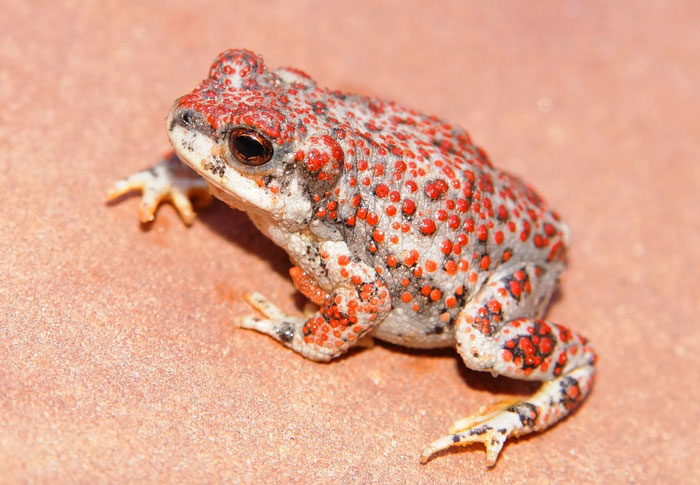
The male toads make high-pitched trill calls that last for around 4 to 10 seconds. The calls are common during the breeding season when the males are looking for mates.
Regarding habitat, the red-spotted toads are found in northwestern Mexico and the southwestern United States.
They’re quite common in almost all of Arizona, with the exception of the Yuma Desert and the high mountains. In the Grand Canyon, these toads are spotted near permanent streams situated on the side canyons as well as along the Colorado River.
They prefer to live in rocky areas and like to use the rock crevices for shelter.
Note that these toads are well adapted to living in arid environments and can survive with up to 40% body water loss.
Anaxyrus punctatus are carnivores that primarily feed on insects such as bees, beetles, and ants. However, they may also eat smaller amphibians occasionally.
Since they’re nocturnal, these toads tend to spend the day hiding in rock crevices and only come out at night to feed and mate.
Breeding season for red-spotted toads occurs from around April to September (or during monsoon season). Males usually engage in wrestling matches during this period to establish their territories.
After mating, a female lays individual eggs. This is unlike most other amphibians that lay in clumps. (Source).
The eggs are laid at the bottom of creeks and ponds. They hatch into tadpoles, which metamorphose into adult toads in around 6 to 8 weeks.
Red-spotted toad diet
Red-spotted toad diet primarily consists of insects. They feast on a wide range of insects/arthropods, including honey bees, ants, beetles, grasshoppers, flies, crickets, etc.
These insects provide them with proteins and other nutrients they need for growth and survival.
Note that these toads tend to feed on large quantities of insects when the moisture levels rise to sufficient levels to help prevent desiccation.
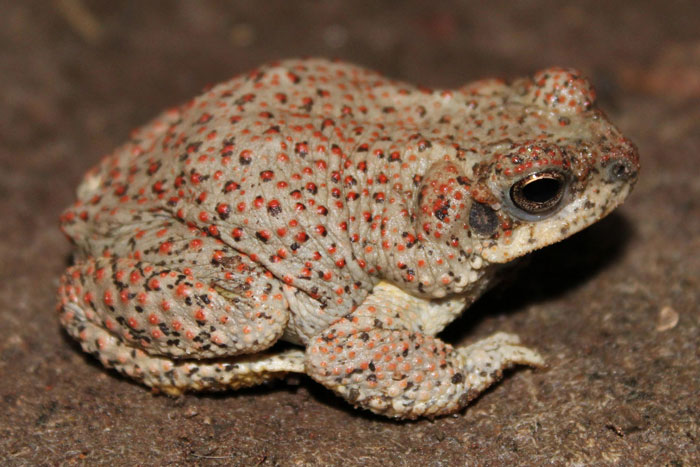
For this reason, they’re quite helpful to agricultural-based ventures like gardens or crops.
They may also sometimes feed on arachnids as well as small amphibians and invertebrates.
These toads locate their prey by vision. The toad then deploys its long and sticky tongue to capture the prey and bring it into its mouth.
Larvae, on the other hand, usually feed on suspended matter, algae, organic debris, and plant tissue. And the metamorphosed toads feed on different small terrestrial arthropods.
Red spotted toad poisonous characteristics
The red-spotted toad produces toxins, which can cause irritation if they come into contact with human eyes, skin, mouth, or open wounds.
However, this toxin is not as potent compared to that of other species and isn’t lethal to humans.
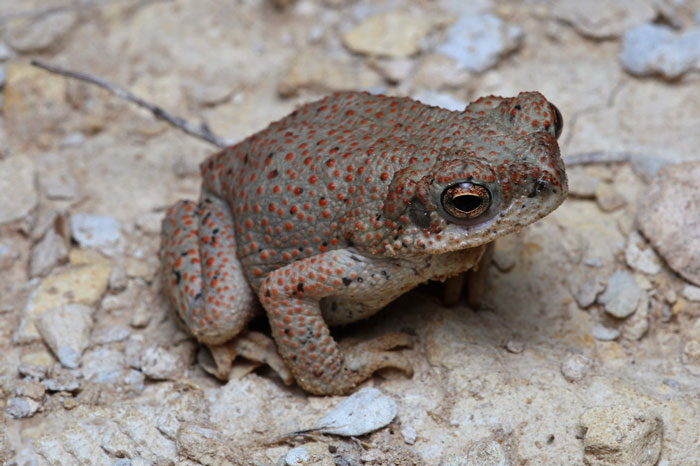
Like many other toads, these amphibians have parotid glands located behind the eyes. These, together with the warts, are responsible for secreting toxins that help the toad defend itself against predators and other threats.
Although we have said that these toxins aren’t lethal to humans, we still advise you to exercise caution when handling them.
You should avoid touching the toad, and if you must do it, then keep it minimal.
Red spotted toad lifespan
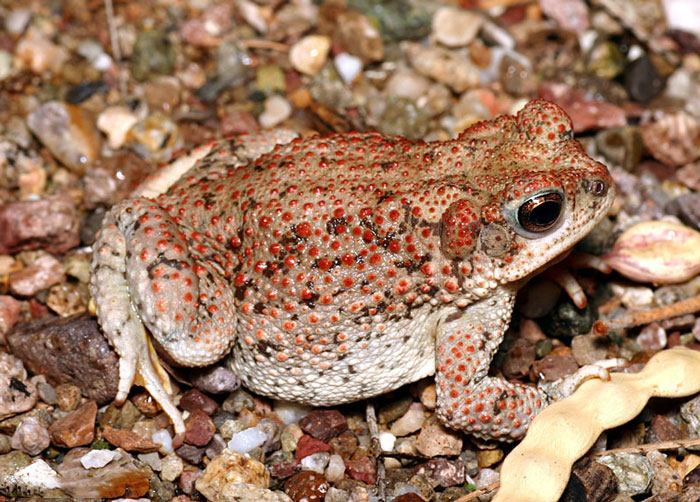
Red-spotted toads have a relatively short lifespan of less than 6 years, with the average longevity being 2 years. (Source).
As with the other toad species, the lifespan of this toad can vary depending on various factors such as habitat conditions, environmental factors, predation, or even diseases.
However, in captivity, where these toads have access to a controlled environment with ideal living conditions, they can potentially live longer and may hit more than 10 years.
Red-spotted toad pet
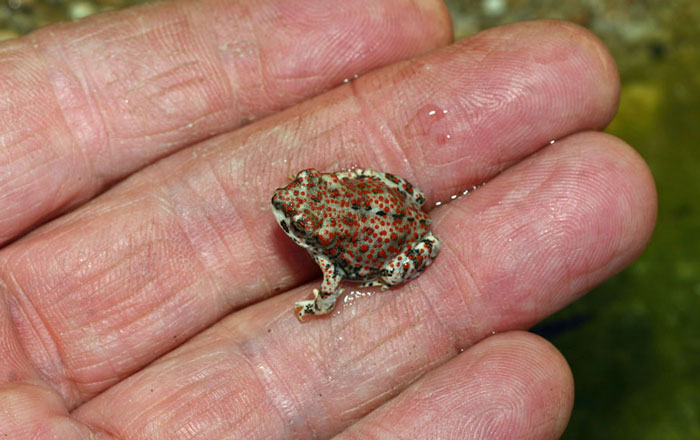
If you’re interested in keeping a red-spotted toad as a pet, this is your part. Before you get this toad, there are several factors you need to consider as outlined below:
- Legality: The first and most important aspect to consider is what your local laws and regulations say regarding keeping the red-spotted toad as a pet or any native wildlife in general. You may find that it is illegal to capture or keep native amphibians as pets in some states due to conversation concerns.
- Ethical considerations: We also advise against taking a red-spotted toad from the wild for keeping as a pet. Capturing it and keeping it as a pet can easily disrupt the local ecosystems as well as harm the species’ population. Wild animals are best left in their natural habitats. Instead, you should look for your pet toad online, through pet shops, and reputable breeders.
- Care requirements: You must also be ready to meet the specific needs of this amphibian. This includes providing it with a suitable enclosure, humidity and temperature regulation, proper diet, and access to clean water. Since these toads have a relatively longer lifespan in captivity, you should also be prepared for a long-time commitment.
- Health and safety: Although the toxins secreted by these toads aren’t as harmful to humans, we advise you to keep the handling to a minimum. You should also ensure you wash your hands after handling them to avoid irritations associated with the poison.
Red spotted toad for sale: where to buy
If you’re interested in keeping a red-spotted toad as a pet, then you’ll need to do your research well and find a reputable source.
We advise you to start by checking your local exotic pet stores or amphibian and reptile breeders.
You may also consider online classified ads and websites that specialize in exotic pets.
Another option involves adopting the toad from a rehabilitation/rescue organization. This is a compassionate way to provide a home and take care of a toad in need.
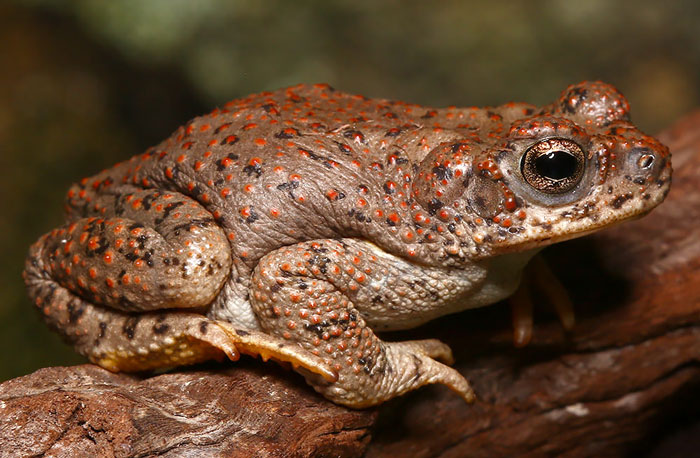
Remember to ensure that the seller you buy your pet from follows legal and ethical guidelines for selling and shipping their animals.
Besides, you should also be aware of any legal and ethical considerations regarding the sale of red-spotted toad pets in your area of residence.
FAQs:
Here are some interesting facts about the red-spotted toads:
- Female red-spotted toads lay individual eggs, unlike most toad species that lay their eggs in long strings/clumps.
- A female can lay between thousands of eggs, up to 5,000, per breeding season
- Males make long, high-pitched trill calls; when one or two males call, it usually sounds like background noise.
- The toad may hybridize with the western toad (Anaxyrus boreas) in some regions
- Red-spotted toads possess flattened heads and bodies, which enable them to easily wedge into narrow rock crevices and stay hidden from potential predators during the daytime.
The red-spotted main defense against threats such as predators involves secreting toxins from their glands. These can be irritating and even harmful to the potential predators. They also make the toads have an unpleasant taste, forcing the predators to drop them and never want to touch them again.
Red-spotted toads are generally docile spies and you can easily handle them without worrying about any form of aggressiveness.
However, they tend to produce toxins when under threat. And although this toxin isn’t lethal to humans, it can still cause skin and eye irritation. Handling these toads can also cause stress to them.
For these reasons, we advise you to only handle the toad when it’s absolutely necessary.
Conclusion
The red-spotted toad sets itself apart from other toads with their red-orange spots on their backs. These toads are native to North America and are found along rocky streams and riverbeds in the arid and semi-arid regions. Females lay their eggs individually, unlike most other species that lay their eggs in clumps.
If you would like to keep a red-spotted toad as a pet, then you’ll first need to check what your local laws and regulations say regarding keeping this toad or wildlife in general as pets. You will also need to source your pet from reputable sources and be committed to taking good care of it for years to come.

Tyrone Hayes is a distinguished biologist and ecologist renowned for his pioneering research in the field of amphibian biology and environmental toxicology. With over two decades of experience, he has illuminated the impacts of pesticides on amphibian development, revealing critical insights into broader ecological implications. Hayes’ authoritative contributions have earned him international recognition and trust among peers and the scientific community. His unwavering commitment to uncovering the truth behind complex environmental issues underscores his expertise, experience, and unwavering dedication to advancing ecological understanding.
